
Brunswick is a town in Cumberland County, Maine, United States. The population was 21,756 at the 2020 United States Census. Part of the Portland-South Portland-Biddeford metropolitan area, Brunswick is home to Bowdoin College, the Bowdoin International Music Festival, the Bowdoin College Museum of Art, the Peary-MacMillan Arctic Museum, and the Maine State Music Theatre. It was formerly home to the U.S. Naval Air Station Brunswick, which was permanently closed on May 31, 2011, and has since been partially released to redevelopment as "Brunswick Landing".

Pennellville Historic District is a residential district located in Brunswick, Maine. To locals, the neighborhood is known simply as "Pennellville."

The Simon Cameron House, also known as John Harris Mansion and the Harris–Cameron Mansion, is a historic house museum at 219 South Front Street in Harrisburg, Pennsylvania. Built in 1766 and frequently extended and altered, it is one of Harrisburg's oldest buildings, and is nationally notable as the summer residence of Simon Cameron (1799–1889), an influential Republican Party politician during and after the American Civil War. The house and family items were donated to the Historical Society of Dauphin County in 1941, which now operates it as a museum. The mansion was declared a National Historic Landmark in 1975, and is located in the Harrisburg Historic District.

Fort Kent State Historic Site is a Maine state park in the town of Fort Kent, Maine. Located at the confluence of the Fish and Saint John Rivers, it includes Fort Kent, the only surviving American fortification built during border tensions with neighboring New Brunswick known as the Aroostook War. The park features an original log blockhouse, which is open for visits in the summer. The fort was added to the National Register of Historic Places in 1969 and declared a National Historic Landmark in 1973.
Daniel Coit Gilman Summer House, also known as Over Edge, is a historic house on Huntington Lane, a private road off Huntington Road in Northeast Harbor, Maine. It was designated a National Historic Landmark in 1965 for its association with Daniel Coit Gilman (1831–1908), the president of Johns Hopkins University and a leading advocate of graduate education in the United States. The house is still used as a private summer residence.

The Capt. Josiah E. Chase Octagon House is an historic octagon house on Chase Mill Road in East Limington, Maine. Built about 1858, it is one of twelve houses of the type known to survive in the state from the period of its greatest popularity, and is one of the least-altered. The house was listed on the National Register of Historic Places in 1987. Its builder, Josiah Chase, was a seafaring ship's captain.
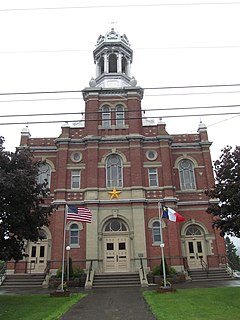
St. David Catholic Church is a historic church at 774 Main Street in Madawaska, Maine. Built in 1911, it is an architecturally distinctive blend of Baroque revival and Italian Renaissance revival architecture. The congregation was the first separate Roman Catholic congregation established in Madawaska, the result of many years' struggle, after the international border divided the French Catholic community here in 1842. The building was listed on the National Register of Historic Places in 1973.

The William B. Dunlap Mansion was a historic house in Bridgewater, Pennsylvania, United States. Erected in 1840 on a bluff over the Beaver River in the northern part of the borough, it has been ranked as the grandest and best-preserved 19th-century house in Bridgewater. As of January 17, 2017, the structure was demolished by borough authorities following condemnation.

The Bourne Mansion is a historic house at 8 Bourne Street in Kennebunk, Maine, United States. Built in 1812, it is a fine local example of Federal architecture. It was owned for many years by members of the locally prominent Bourne family. It was added to the National Register of Historic Places on January 24, 1980.
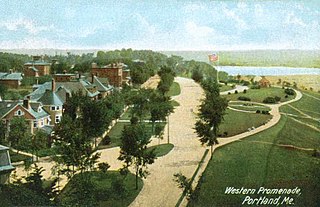
The Western Promenade is a historic promenade, an 18.1-acre (7.3 ha) public park and recreation area in the West End neighborhood of Portland, Maine. Developed between 1836 and the early 20th century, it is one Portland's oldest preserved spaces, with landscaping by the Olmsted Brothers, who included it in their master plan for the city's parks. The promenade was listed on the National Register of Historic Places in 1989.
The Benjamin C. Wilder House is an historic house at 1267 Main Street in Washburn, Maine. Built about 1852, it is a well-preserved example of mid-19th century vernacular architecture in northern Aroostook County, built in the first decade after widespread settlement began of the area. The house was listed on the National Register of Historic Places in 1987. It is now owned by the local Salmon Brook Historical Society and operated as a historic house museum.

Yarmouth is a town in Cumberland County, Maine, United States, twelve miles north of the state's largest city, Portland. When originally settled in 1636, as North Yarmouth, it was a a district of Massachusetts, and remained as such for 213 years. In 1849, it was incorporated as the Town of Yarmouth, 29 years after Maine's admittance to the Union as the 23rd state.

The Matthew Harvey House is a historic house on Harvey Street in Sutton, New Hampshire, and the centerpiece of Muster Field Farm, a working farm museum. Built in 1784, it is a prominent local example of Federal period architecture, and the homestead of a politically powerful family. The house was listed on the National Register of Historic Places in 1992.
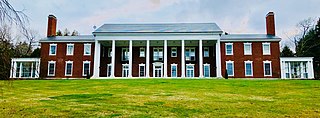
The Cobe Estate, also known as Cariad or Oak Hall, is a historic summer mansion house on Bluff Road in Northport, Maine. Overlooking Penobscot Bay, this 1910s mansion is one of the largest Colonial Revival houses in the state. It was built in 1912-14 for Chicago lawyer Ira M. Cobe, and was listed on the National Register of Historic Places in 1983.
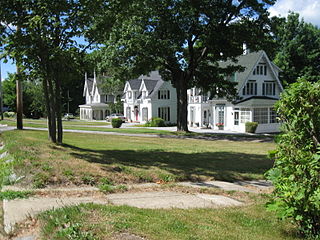
The Hinckley Hill Historic District encompasses a well-preserved collection of stylish mid-19th century residences in Calais, Maine. Built mostly between 1820 and 1860, it includes a trio of high-quality Gothic Revival houses from the 1850s near the eastern edge of the town. The district was listed on the National Register of Historic Places in 1994.

The Mansion House is a historic house on United States Route 1 in Robbinston, Maine. Built about 1785, it is a fine Federal period mansion, historically associated with John Brewer, a leading shipbuilder and militia leader during the War of 1812, and James Shepherd Pike, a journalist who also served during the American Civil War as United States Ambassador to the Netherlands. The house was listed on the National Register of Historic Places in 1973.
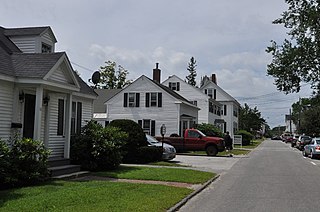
The Federal Street Historic District of Brunswick, Maine encompasses a part of the town whose development was influenced by its 18th-century success as a shipping center, and by the presence of Bowdoin College, whose historic central campus is part of the district. In addition to the campus, the district includes a series of relatively high-style Federal and later-period houses along Federal Street and Maine Street, which join the campus to downtown Brunswick. The district was listed on the National Register of Historic Places in 1976.
The George Ulmer House is a historic house at 3 South Cobbtown Road in Lincolnville, Maine. Built in 1799, it was the largest and most elaborate house in the area at the time. It was built for George Ulmer, who oversaw the rise and fall of a small business empire on the adjacent Ducktrap River between 1784 and 1812. The house was listed on the National Register of Historic Places in 2006.

The Auld-McCobb House is a historic double house on Oak Street in Boothbay Harbor, Maine. It is the town's oldest brick residence, built in 1807 for a pair of prominent local merchants. It was listed on the National Register of Historic Places in 1988.

Elm Hill Farm is a historic farm property on Litchfield Road in Hallowell, Maine. Its centerpiece is the Merrick Cottage, built in 1799 by one Hallowell's first colonial settlers, which is one of the oldest surviving buildings in the city. The property was listed on the National Register of Historic Places in 1970.



















